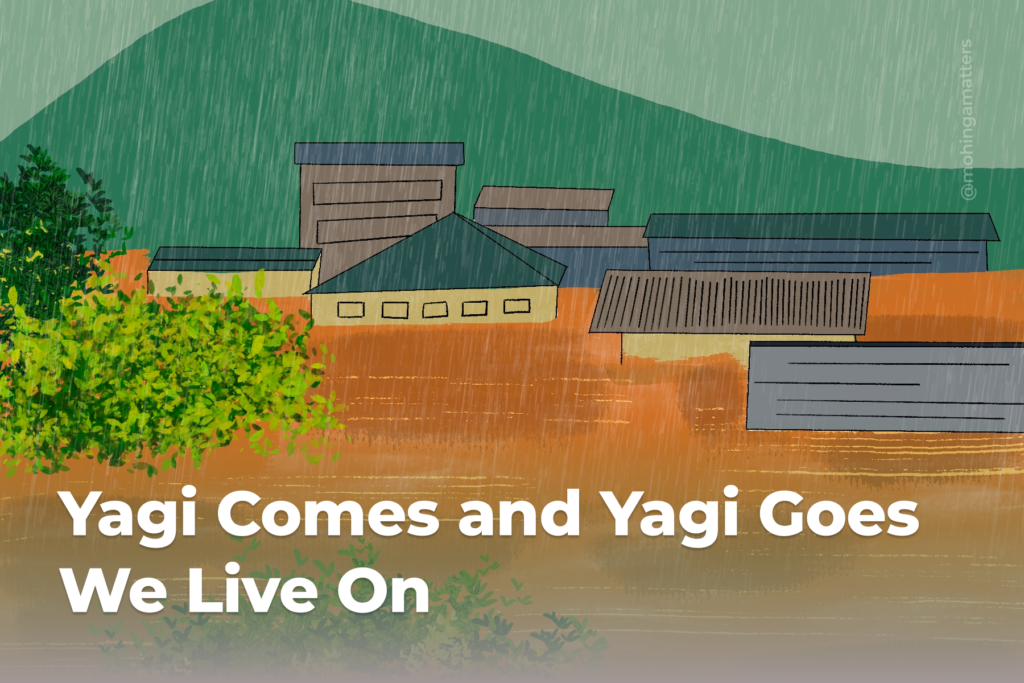We Live On

More than a million people were affected by floods, hundreds of thousands of houses, farmlands, livestock, and other assets were destroyed, hundreds died by drowning with more missing – the floods from Typhoon Yagi caused much devastation across Myanmar. While the country did not face the typhoon itself directly, the floods and landslides, combined with the junta’s apathy and weaponizing of the disasters were more than enough to have the largest fatality among all countries directly or indirectly impacted by Yagi. Considering such a large-scale disaster hitting a war-torn populace, we couldn’t help but ponder what this means for the people of Myanmar, both in the short-term, i.e. the immediate well-being and disaster relief, and in the long term, i.e. our march towards a just and fair society under federal democracy.
In considering the short-term impacts, the prospects are grim. While the country has been reeling from war and poverty over the past three years, the people of Myanmar and Myanmar diaspora communities abroad still showed admirable efforts to help flood victims. However, the junta’s administration, the State Administration Council (SAC), did its best to disrupt relief efforts. Often it was reported that SAC restricted relief efforts towards flood-affected areas, seizing lifesaving food, medication, and other items and arresting volunteers. SAC’s appeal to help from the international community, while restricting the flow of aid in the country, is a method repeatedly used before. If the junta blatantly arrested medical workers, seized medicines, and shut down oxygen factories even in cities under the eyes of international media, when COVID-19 was ravaging the country back in 2021, the audacity in weaponizing disasters in rural areas is not unrealistic. Critics point out that, while the junta reportedly raised over MMK 40 billion, hardly any was seen used for disaster relief, and that also echoed how the junta seized funds for COVID-19 relief in 2021. In every disaster, the junta’s method is to enrich themselves while stopping aid to its enemies, i.e. the people, and that caused not even unmitigated but rather amplified death and suffering to the people. Moreover, in areas, where the junta is not in control, while the other means of disruption become less practical for the junta, they did try their best to cause trouble through airstrikes.
In the medium term, a bigger death toll, albeit less reported, would come from consequences in health, malnutrition, and increased poverty in the aftermath of the floods. For instance, the junta’s deliberate weaponizing of disasters would be further compounded by mismanagement and inward-looking economic policies since the coup. After the baseless claims of NLD committing voter fraud, one of the most frequent reasons cited by Min Aung Hlaing for staging the coup is (another equally baseless) claim about how Myanmar’s economy performing badly under the NLD administration. He claims the reason behind poor economic performance is the economy’s import reliance status. In his speeches on SAC delivering prosperity, Min Aung Hlaing does not mention GDP (national income), the most important indicator of the economy but rather how import spending was reduced under his administration. This dislike for imports became more and more problematic over time as essential items such as fuel and medicine, which have little domestic production capacity, have faced heavy restrictions over the past year. In late August, the junta’s restriction of medicine imports and scrutiny of pharma importers reached a peak. Enters the flood and these policies on medicines alone will yet claim more deaths.
Destruction of productive capitals such as farmlands, workshops, and infrastructures such as roads will also exacerbate poverty. For 2024 Myanmar’s GDP growth rate, the World Bank predicted 1% and the Asian Development Bank predicted 0.8%. By year-end when updated rates were to be calculated, it wouldn’t be surprising if we turned yet another negative economic growth, and this will pile more misery on the people of Myanmar, disproportionately to half the population who are already living in poverty (UNDP). Moreover, considering another 25% of the population is just one shock away from poverty (UNDP), it is expected that many of them will now slide into poverty.
For the pro-revolution forces, it could be argued that people’s focus and resources are now shifted towards survival and the junta will exploit this episode of tragedy to gain legitimacy and pile more misery on the people, a supporting base for the revolution. However, in previous episodes, while the people’s suffering got deeper, none of the wanton atrocities tipped the scale in the junta’s favor. Recent history demonstrated that shooting up peaceful protestors only caused people to stop protesting and pick up arms. Likewise, weaponizing the pandemic did not generate the docility that the junta craved but rather served as a reminder of how the future under the junta would bring forth and foster support for the revolution. Burning down of villages and wanton airstrikes also stoked resistance fervor leading to the junta losing control of these areas. Many times, the junta unleashed hell and many times the people endured to resist the junta. In our long and painful march, what happens now is the junta losing more and more ground each year. Once again, there will be no long-term and concrete gain for the junta by this episode of weaponizing the disaster.
However, how the revolutionary leadership and the people respond would have a more profound impact on our future. Traditionally, Myanmar is a divisive country along racial, geographical, and religious lines. And despite many claims of each area being an ancestral land or under the influence of one ethnicity, the fact is that even in sub-state areas, such as township levels, hardly any area these days is resided by one ethnicity alone. Creating cohesion across people of different racial and religious backgrounds in post-disaster settings would be of paramount importance to create lasting peace and prosperity in these areas and at the national level. Also, here, we appeal not just to the ordinary citizens but also to the leadership because the reality is that elite voices dominate policy, and while the kindness of the citizens is never in doubt, this kindness and potential cohesion could be driven away by the elites’ attempt to build hegemony. However, this is just a caution and not foreshadowing of what might happen. If any, the Spring Revolution three years on has repeatedly proven that the windows for elites usurping power without the consent of the people is ever diminishing.
The junta has proven time and time again that their focus is on destroying and they are pretty good at it. Our pro-revolutionary side’s focus is on rebuilding immediate relief while paving the way for the long term. And by looking at how far we have come, learned, and improved, even in light of the current state of devastation brought up by Yagi, we still think there are more reasons to be optimistic than otherwise in the long term.

